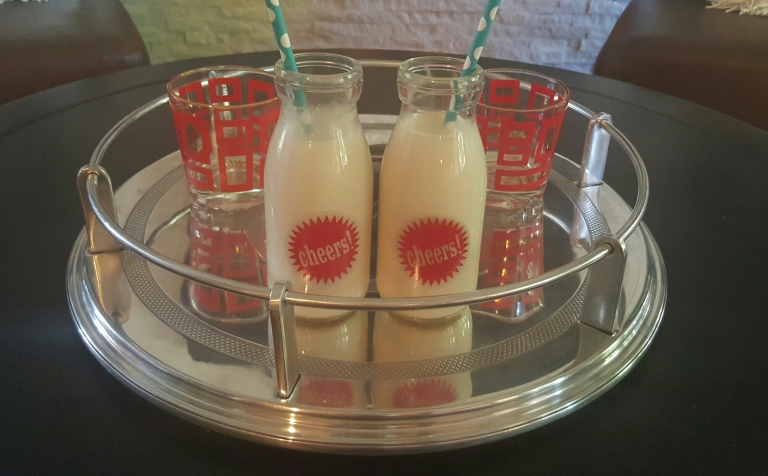Homemade Almond Milk: Tastes Great and It’s Oh, So Simple!
Almond milk has pushed its way near the front of the line with today’s more conscientious shoppers. Aside from being a plus for those with dairy allergies or lactose intolerance, and anyone looking to shave off excess calories (unsweetened almond milk is only about 30 calories per serving!), a cool glass of fresh almond milk also serves up some terrific flavor!
For at least a couple years, I brought home store-bought brands in half-gallon cardboard containers (we liked the unsweetened vanilla variety – and paid anywhere from $3 to $4 for each half gallon. Still less than what we’d pay for high-quality organic dairy milk, so we didn’t give it much thought). Then we started really exploring what was IN the store-bought almond milk we regularly bought. Here are just some of the more common ingredients: almond milk (almonds and filtered water); cane syrup; vanilla flavoring (note “flavoring” – not exactly the real deal); sea salt; potassium citrate; guar gum or carrageenan – the latter of which is an ingredient I avoid because of reports that it may be carcinogenic (cancer causing); riboflavin; vitamin A Palmitate; sunflower lecithin; vitamin B2, and the list could go on.
I decided to get back to basics and make our own. I bought a 10-pound bag of raw, organic almonds from Amazon (you certainly don’t need to buy that crazy amount – I just did to save some cash because I knew I’d be using them up quickly with the weekly batches I’d be making) and spent some time in the kitchen to concoct the simplest, best-tasting, wholesome almond milk I could. I’m happy to report our homemade milk takes only five ingredients (and one of those is water!).
Aside from the ingredients below, you’ll need the following kitchen gadgets:
one gallon glass jar or pitcher (for soaking your almonds in water — you’ll do this first!);
high-powered blender (Vitamix, Blendtec, Ninja, etc. work beautifully for pulverizing the almonds);
one medium-size bowl;
one large bowl;
one large pouring/spouted container (such as a batter bowl, if you have one. It’ll come in handy later, believe me);
mesh nut milk bag (it’s an inexpensive purchase that really delivers a smooth, pulp-free milk); and
wire whisk
| Servings |
|
- 2 c. organic raw almonds (blanched – more on that below)
- 4 c. cold filtered water filtered water (tap water can alter the taste, and nota good way)
- 2-3 tsp. pure organic vanilla extract (you can also use vanilla beans if you choose)
- 1-2 tsp. ceylon cinnamon I recommend the Ceylon variety because it is hailed the “real cinnamon”
- 1 pinch Fine sea salt
Ingredients
|
- * If you prefer your almond milk sweetened, you may certainly add a natural sweetener (many recipes call for you to toss a couple Medjool dates into the blender to lightly sweeten; however, I’d recommend sweetening to taste by the glass -- blending up a glassful of almond milk with a half a date, for example), as opposed to sweetening the entire pitcher/container. Sugars can hasten bacterial growth and shorten the lifespan of your milk. Just my two cents, though!). You may also sweeten to taste with raw, local honey, raw maple syrup, a dash of pure stevia or good ol’ fashioned organic cane sugar.
- Add 2 cups of raw organic almonds to a tall glass jar and fill halfway up with cool water. Soak the almonds in the water for several hours, or until the skins peel off easily between your fingers. Skins have enzyme inhibitors, which make almonds difficult for many people to digest; soaking almonds and removing the skins aids digestion and helps unlock nutrients. I use a one-gallon jar to soak my almonds because I make more than a gallon of almond milk a week, which requires multiple batches of this recipe – but even if you’re making far less, the larger jar makes it easier to fit your hand into the mouth to gather the soaked almonds).
- Dip your clean hand into the jar to remove a small handful of soaked almonds and then place your hands over the large mixing bowl. One by one, remove the skins (the skin should roll or slide off easily as you roll the almond between your thumb and index finger) and place the almonds in a separate, clean, medium-size bowl. Tip: I skin the almonds over a large/deep bowl, so I can place my hands inside and not have the slippery almonds shooting out of my fingers and across the room – just one of the lessons I’ve learned that I wanted to pass along.)
- Once all almonds are skinned, dump the nuts into a strainer and give them a good rinse under cold water. Set the skinned (blanched) almonds aside. You can toss the skins in the trash or, even better, add them to your composter.
- Add one cup of your rinsed almonds to your blender and top with 4 cups of cold, filtered water.
- Blend on high speed for 30 to 60 seconds (more or less, depending upon your blender’s power – you want to really pulverize the almonds and create a nice, even liquid with no chunks. Avoid over-blending, though, which can heat up the almond milk and hasten spoiling).
- Now for the fun part (and it’ll be easier if you have a helper, although it’s not entirely necessary): Place a large bowl in the kitchen sink (ideally, a bowl with a pouring spout or lip – but again, not necessary if you don’t have one handy). Open your mesh nut bag and place it inside the bowl, and then pour your pitcher of almond milk into the bag.
- Pull the drawstrings on the bag and gently work the milk through the bag and into the bowl below, squeezing, pressing and wringing slightly to remove as much moisture as possible and extract the most milk. Note: See that amazing, semi-dry pulp that’s left over in the bag? DON’T TOSS IT! It’s delicious blanched almond flour – which costs a fortune at the store! – and all you’ll need to do is spread it out on a parchment paper-covered cookie sheet and dry it out on your oven’s lowest heat setting for a few hours. No time to dry it right away? Put it in a freezer-safe bag or container and toss it in the freezer.
- Now, add 1 to 2 teaspoon of Ceylon cinnamon, 2 to 3 teaspoons of vanilla extract (I love cinnamon and vanilla, so I use a lot; you may use less) and a pinch of sea salt to the bowl of strained milk. Give it a good, brisk whisk. Note: Many almond milk recipes call for the cinnamon, vanilla and salt to be whisked into the mixture BEFORE straining through the mesh bag; however, I find this wasteful because it’ll also end up seasoning your pulp/flour, as opposed to just the milk). Adding it to the strained milk gives it more pronounced flavor.
- Empty the almond milk into a glass mason jar (you should have roughly 32 ounces – half the container).
- To fill the rest of the ½-gallon container, simply repeat all the above steps once more.
- Refrigerate your milk (if you’re using high-quality, fresh almonds and keeping the milk very cold in the fridge, it should last about a week. We’ve had ours last up to ten days, but we keep our fridge on 38 degrees and store the milk in the door’s dedicated milk compartment, which supposedly keeps things even colder. If it’s not kept cold, it can spoil quickly – and who wants their efforts to go to waste?!?).
- Another tip: Your milk may quickly separate (you might see some streakiness), but that doesn’t mean it’s gone bad! Just give it a good shake or stir with a wooden spoon before pouring. I always gauge my milk’s freshness with my nose. If it smells good, it is. If it’s even a little sour or “off,” it’s past it’s prime.
Pour a glass and enjoy the fruits of your labor!


Love this!!! I have been using store bought almond milk but worry about the chemicals in those nasty cardboard containers not to mention what chemical compounds are lurking in the actual processed almond milk.